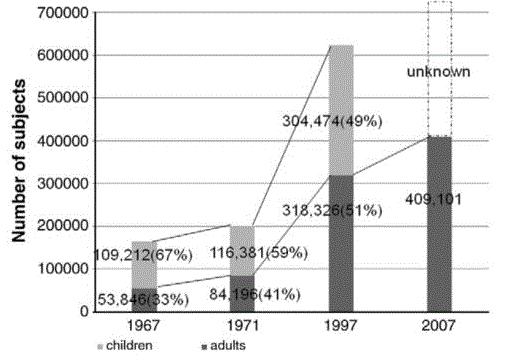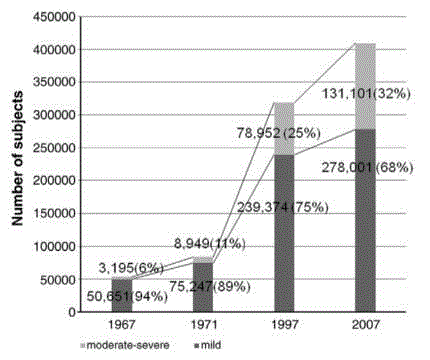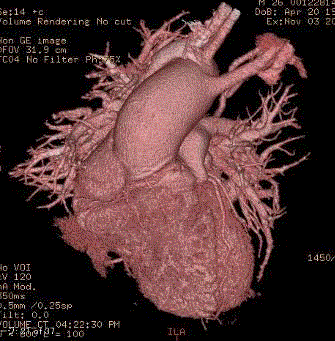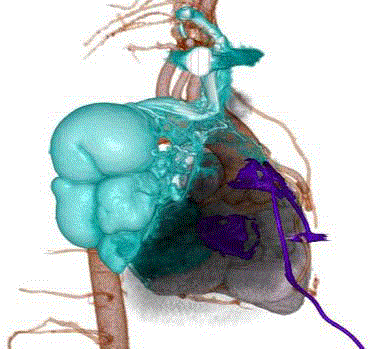Review Article
Surgical Intervention for Adult Congenital Heart Disease: Emerging Population
Kozo Matsuo*, Masashi Kabasawa, Takahiro Ito, Shintaroh Koizumi, Hiroki Ikeuchi, Hideomi
Hasegawa, Shinichiro Abe, Soichi Asano, Naoki Hayashida and Hirokazu Murayama
Department of Cardiovascular Surgery, Chiba Cerebral and Cardiovascular Center, Japan
*Corresponding author: Kozo Matsuo, Department of Cardiovascular Surgery, Chiba Cerebral and Cardiovascular Center, 575 Tsurumai, Ichihara city, Chiba, 290- 0512, Japan
Published: 14 Mar, 2018
Cite this article as: Matsuo K, Kabasawa M, Ito T,
Koizumi S, Ikeuchi H, Hasegawa H,
et al. Surgical Intervention for Adult
Congenital Heart Disease: Emerging
Population. Clin Surg. 2018; 3: 1936.
Abstract
Improvement of surgical results and medical management for Congenital Heart Diseases (CHD)
led emerging population of the adult patients. However, corrective surgery for complex CHD
does not always mean complete cure. Increasing number of adult patients with CHD (ACHD)
will visit the cardiology facilities because of secondary or residual lesions. Conduit malfunction,
valvular insufficiency, association of arrhythmias and so forth are common in ACHD patients and
sometimes critical.
We experienced 265 surgical procedures for ACHD patients at our center between 1999 and 2015.
Of these procedures, palliative surgery was performed in 3%, palliation to corrective surgery in 6%,
primary repair in 57%, and redo surgery in 34%. Hospital mortality within 30 days in this period
was 1.1%.
Surgery for ACHD patients is safe and beneficial treatment, however tailored procedures for the
individual patient are essential to obtain the optimal quality.
Keywords: Adult congenital heart disease; Congenitally corrected transposition of great artery;
Pulmonary valve replacement; Reoperation
Introduction
Due to improvement of surgical outcome and medical management, majority of the patients with congenital heart disease (CHD) can reach their adulthood [1,2]. In our country, the population of adult patients with CHD has increased to over 450,000 and it has surpassed that of young patients (Figure 1a) and a percentage of complex CHD has also been increasing among ACHD patients (Figure 1b) [2]. This situation is the same current in the most of advanced countries [3,4]. However, corrective surgery for complex CHD does not always mean curative. Quite a few patients leave their cardiac defects untreated or remain palliative stage. These patients are prone to visit the tertiary referral facilities associated with severe symptoms. Since there are few distinct evidences to determine the surgical intervention for the ACHD patients with various morbidity at present, tailored treatment will be essential depends on individual conditions of the patients.
Primary Repair
Atrial Septal Defect (ASD) is the most common CHD remained unrepaired among the adult
patients. Ventricular Septal Defect (VSD), Patent Ductus Arteriosus (PDA), or Ebstein diseases are
also frequently presented unrepaired till adulthood. However congenitally corrected transposition
of great arteries (ccTGA) is uncommon disease, 0.5% of all the CHD [5], adult cardiologists tend to
encounter and are sometimes confused to diagnose correctly. Even nowadays, it is not seldom that
the patients with cyanotic disease such as tetralogy of Fallot (TOF) (Figure 2), or morphologically
univentricular heart with well-balanced pulmonary obstruction are introduced for the first
intervention.
Recently medicines for pulmonary arterial hypertension (PAH) treatment have been
dramatically developed. Several endothelin receptor antagonists, Phospodiesterase-5 inhibitors and
prostacyclin analogues are now available for clinical use. Advanced and dynamic criteria have been
indicated for ASD and VSD with PAH in the recent guidelines concerning the management of
ACHD, that is, closure of the defect is suggested when pulmonary arterial pressure and pulmonary
vascular resistance significantly decrease to targeted figure with in halation of oxygen, inhalation of
nitrogen monoxide, or treatment with PAH medicines [6]. Based on these guidelines, the concept of “treat and repair” has been practiced for the patients with CHD and severe PAH [7,8].
Double discordance between atrio-ventricular and ventriculoarterial
connection is conspicuous characteristic of ccTGA. The
morphological RV and the tricuspid valve accept systemic circulation.
Therefore more than 80% of the adult patient tend to have TR and
over 30% of them experiences RV dysfunction or congestive heart
failure in their middle age and the rate increases with age [9]. Surgical
outcome of ccTGA has been reported not satisfactory in the previous
studies [10]. Mongeon et al. [11] reviewed 46 case of tricuspid valve
replacement (TVR) performed at a single center. They found that
63% of the patients who had pre-operative RV ejection fraction
(RVEF) ≥40% maintained over post-operative RVEF ≥40%, whereas
only 10.5% of the patient with RVEF < 40% kept pre-operative value.
Asymptomatic ccTGA should be continuously followed-up and be
referred to surgical consultation at earlier timing after diagnosis of
new onset TR is made [12]. TVR would be the first choice for the
adult patients with ccTGA and TR [9,11,13].
Figure 1a
Figure 1a
Change of total number of CHD. The ACHD patient population
has increased to over 450,000 and it has surpassed that of young patients
in 2007 [2].
Figure 1b
Figure 1
Severity of CHD in adult patients. A percentage of complex CHD
has been increasing since 1997 [2].
Figure 2
Figure 2
Enhanced CT image of 26 year-old man with TOF, pulmonary
atresia and major aorto-pulmonary collateral arteries (MAPCAs). Pulmonary
blood flow was supplied mainly through three MAPCAs (blue, green and
red arrows). Since the ascending aorta was enlarged to 57 mm in diameter
associated with grade 2 of aortic valve regurgitation, unifocalization of the
pulmonary artery, Rastelli procedure and ascending aortic replacement were
performed concomitantly.
Figure 3
Figure 3
CT image of 35 year-old women who underwent atrio-pulmonary
connecting Fontan operation at 5 years old. She suffered from easy fatigue
and hypoxemia around 80% of SpO2. She developed extraordinarily dilated
veno-venous collateral from SVC to right lower pulmonary vein. Conversion
to extracardiac TCPC and ligation of collateral vessels were performed.
Reoperation
Corrective surgery for CHD does not always mean curative.
Pulmonary valve Regurgitation (PR) in repaired TOF and malfunction
of the conduits are the most frequent reasons that need re-operation
in the long follow-up period [14]. PR is inevitable when RVOT in
TOF has been repaired with a transannular patch. Consequent RV
dilatation will trigger RV dysfunction, wide QRS and sometimes
ventricular tachyarrhythmia (VT). Gatzoulis et al. [15] described
VT would increase 25 to 30 years after TOF repair and strong
relevant of PR to VT and sudden death. Indications of Pulmonary
Valve Replacement (PVR) for repaired TOF are now considered
as moderate to severe PR, RVEDVI over 160~180 ml/m2, QRS
duration exceeding 180 ms and so on [16-19]. Usually at issue valve
is selected for PVR because long durability can be expected at the
low-pressured pulmonary position and unnecessity of anticoagulant
[20,21]. Regardless valved or non-valved, the conduit used for RVPA
connection become malfunction due to somatic growth, or
degeneration of the conduit valve with time. When the patients are
associated with symptoms like breathlessness on excretion, fatigue,
abdominal distension, and objective symptoms as QRS widening,
moderate to severe regurgitation or pressure gradient excessing 50
mmHg across the conduit, conduit exchange would be recommended.
In classical atrio-pulmonary connecting Fontan (APC-Fontan),
the RA is disposed to be excessively dilated with time because of
chronic high CVP. Resultant stagnant blood flow in the RA may
cause decreased cardiac output and thrombus formation. Reentrant tachyarrhythmia around the surgical scar, atrial flutter or atrial
fibrillation will appear in significant population of the patients
[22]. Some patients develop veno-venous collateral vessels owing
to high CVP and these vessels cause significant desaturation when
they return to the pulmonary vein (Figure 3). Mavroudis et al. [23]
advocated that conversion to extra cardiac total cavo-pulmonary
connection (TCPC) concomitant arrhythmia surgery rescued
such “failing” classical Fontan. The authors excised the sinus node
together with damaged RA wall because it is nonfunctional in vast
majority of the patients with failing Fontan [23,24]. However, some
authors preserved the sinus node [25,26] and implanted DDD type
pacemaker to prevent bradycardia. The route between inferior vena
cava and the PA is reconstructed with an ePTFE tube of 18 mm to 22
mm diameter.
Reentry of sternotomy is always challenging in ACHD patients.
Dilated RV, anteriorly positioned ascending aorta or calcified RVPA
conduit may lie immediately beneath, or sometimes adhered to
the sternum. It is indispensable to examine retrosternal space and
anatomical characteristics preoperatively by CT or MRI. If the risk
of heart injury deemed high, femoro-femoral partial bypass should
be started to reduce cardiac volume and to perform sternal reentry
safely. Any intracardiac shunt (residual ASD or VSD) must be
carefully inspected to avoid hazardous air embolism in case that heart
injury might take place [27].
Stellin et al. [28] analyzed 1,247 of ACHD patients enrolled in
the multicenter study during 5 years from 1997. The patients were
divided into 3 groups; 4.4% of palliative procedures, 79.3% of repair
(corrective surgery) and 16.3% of reoperation. There was 2.4% of
hospital mortality within 30 days. We experienced 265 surgical
procedures for ACHD patients at our center between 1999 and 2015.
Our data shows almost the same tendency as the Stellin’s report;
palliation in 3%, palliation to correction in 6 %, repair in 57%, and
redo surgery in 34%. Despite progressive changes in complexity and
severity of ACHD, hospital mortality within 30 days in this period
was 1.1%. We conclude that surgery for ACHD patients is a safe and
beneficial treatment.
Standardized and evidence-driven treatment and care should be
perused; however tailored treatment is essential to obtain the optimal
quality for the individual patient. A comprehensive multidisciplinary
approach are required to achieve this goal [27,29].
References
- Niwa K, Akagi T, Ichikawa H. Guidelines for management of congenital heart disease in adults (2011 revised edition). JCS. 2011;1-135.
- Shina Y, Toyoda T, Kawasoe Y, Tateno S, Shirai T, Wakisaka Y, et al. Prevalence of adult patients with congenital heart disease in Japan. Int J Cardiol. 2011;146(1):13-16.
- Williams WG, Webb GD. The emerging adult population with congenital heart disease. Semin Thorac Cardiovasc Surg Pediatr Card Surg Annu. 2000;3(1):227-33.
- Stuart AG. Changing lesion demographics of the adult with congenital heart disease: an emerging population with complex needs. Future Cardiol. 2012;8(2):305-13.
- Filippov AA, Del Nido PJ, Vasilyev NV. Management of systemic right ventricular failure in patients with congenitally corrected transposition of the great arteries. Circulation. 2016;134(17):1293-302.
- Baumgartner H, Bonhoeffer P, De Groot NMS, de Haan F, Deanfield JK, Galie N, et al. ESC guidelines for the management of grown-up congenital heart disease. Eur Heart J. 2010;31(23):2915-57.
- Dimopoulos K, Peset A, Gatzoulis MA. Evaluating operability in adults with congenital heart disease and the role of pretreatment with targeted pulmonary arterial hypertension therapy. Int J Cardiol. 2008;129(2):163-71.
- Schwerzmann M, Zafar M, McLaughlin PR, Chamberlain DW, Webb G, Granton J. Atrial septal defect closure in a patient with "irreversible" pulmonary hypertensive arteriopathy. Int J Cardiol. 2006;110(1):104-7.
- Graham TP Jr, Bernard YD, Mellen BG, Celermajer D, Baumgartner H, Cetta F, et al. Long-term outcome in congenitally corrected transposition of the great arteries: a multi-institutional study. J Am Coll Cardiol. 2000;36(1):255-61.
- Hraska V, Duncan BW, Mayer JE JR, Freed M, del Nido PJ, Jonas RA. Long-term outcome of surgically treated patients with corrected transposition of the great arteries. J Thorac Cardiovasc Surg. 2005;129(1):182-91.
- Mongeon FP, Connolly HM, Derabi JA, Li Z, Warnes CA. Congenitally corrected transposition of the great arteries ventricular function at the time of systemic atrioventricular valve replacement predicts long-term ventricular function. J Am Coll Cardiol. 2011;57(20):2008-17.
- Bacha E. Patients with congenitally corrected transposition of the great arteries and systemic tricuspid valve regurgitation should be referred for surgical consultation as soon as the diagnosis of regurgitation is made. J Am Coll Cardiol. 2011;57(20):2018-9.
- Scherptong RW, Vliegen HW, Winter MM, Holman ER, Mulder BJ, van der Wall EE, et al. Tricuspid valve surgery in adults with a dysfunctional systemic right ventricle: repair or replace? Circulation. 2009;119(11):1467-72.
- Mizuno A, Niwa K, Matsuo K, Kawada M, Miyazaki A, Mori Y, et al. Survey of reoperation indications in tetralogy of fallot in Japan. Circ J. 2013;77(12):2942-7.
- Gatzoulis MA, Baraji S, Webber SA, Siu SC, Hokanson JS, Poile C, et al. Risk factors for arrhythmia and sudden cardiac death late after repair of tetralogy of Fallot: a multicentre study. Lancet. 2000;356(9234):975-81.
- Geva T. Indication and timing of pulmonary valve replacement after tetralogy of Fallot repair. Semin Thorac Cardiovasc Surg Pediatr Card Surg Annu. 2006;11-22.
- Therrien J, Provost Y, Merchant N, Williams W, Colman J, Webb G. Optimal timing for pulmonary valve replacement in adults after tetralogy of Fallot repair. Am J Cardiol. 2005;95(6):779-82.
- Scherptong RW, Hazekamp MG, Mulder BJ, Wijers O, Swenne CA, van der Wall EE, et al. Follow-up after pulmonary valve replacement in adults with tetralogy of Fallot: association between QRS duration and outcome. J Am Coll Cardiol. 2010;56(18):1486-92.
- Hirose N, Matsuo K, Kabasawa M. The mid-term effects of pulmonary valve replacement on right ventricular function in adult patients with tetralogy of Fallot. Journal of Adult Congenital Heart Disease. 2013;2:22-8.
- Burchill LJ, Wald RM, Harris L, Colman JM, Silversides CK. Pulmonary valve replacement in adults with repaired tetralogy of Fallot. Semin Thorac Cardiovasc Surg Pediatr Card Surg Annu. 2011;14(1):92-7.
- Sabate Rotes A, Eidem BW, Connolly HM, Bonnichsen CR, Rosedahl JK, Schaff HV, et al. Long-term follow-up after pulmonary valve replacement in repaired tetralogy of Fallot. Am J Cardio. 2014;114(6):901-8.
- Gelatt M, Hamilton RM, McCrindle BW, Gow RM, Williams WG, Trusler GA, et al. Risk factors for atrial tachyarrhythmias after the Fontan operation. J Am Coll Cardiol. 1994;24(7):1735-41.
- Mavroudis C, Backer CL, Deal BJ, Johnsrude C, Strasburger J. Total cavopulmonary conversion and maze procedure for patients with failure of the Fontan operation. J Thorac Cardiovasc Surg. 2001;122(5):863-71.
- Backer CL. 12th Annual C. Walton Lillehei Memorial Lecture in Cardiovascular Surgery: Fontan conversion--the Chicago experience. Cardiol Young. 2011;21:169-76.
- Hiramatsu T, Iwata Y, Matsumura G, Konuma T, Yamazaki K. Impact of Fontan conversion with arrhythmia surgery and pacemaker therapy. Eur J Cardiothorac Surg. 2011;40(4):1007-10.
- Sridhar A, Giamberti A, Foresti S, Cappato R, Garcia CR, Cabrera ND, et al. Fontan conversion with concomitant arrhythmia surgery for the failing atriopulmonary connections: mid-term results from a single centre. Cardiol Young. 2011;21(6):665-9.
- Brown ML, Dearani JA, Burkhart HM. The adult with congenital heart disease: medical and surgical considerations for management. Curr Opin Pediatr. 2009;21(5):561-4.
- Stellin G, Vida VL, Padalino MA, Rizzoli G; European Congenital Heart Surgeons Association. Surgical outcome for congenital heart malformations in the adult age: a multicentric European study. Semin Thorac Cardiovasc Surg Pediatr Card Surg Annu. 2004;7:95-101.
- Vouhe P. [Surgery for congenital heart disease in the adult: characteristics]. Arch Mal Coeur Vaiss. 2002;95(11):1023-6.




